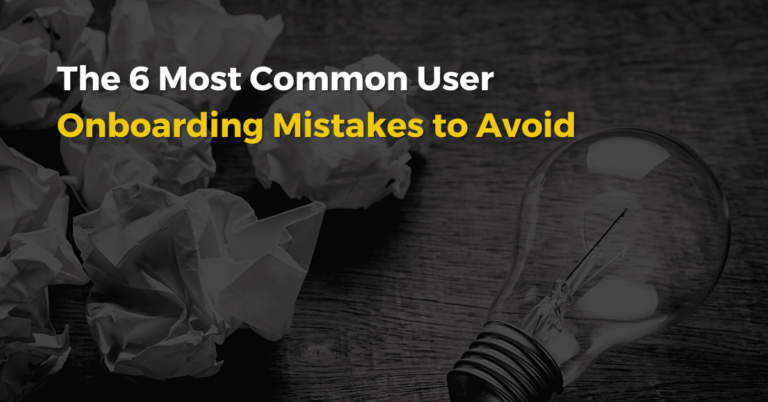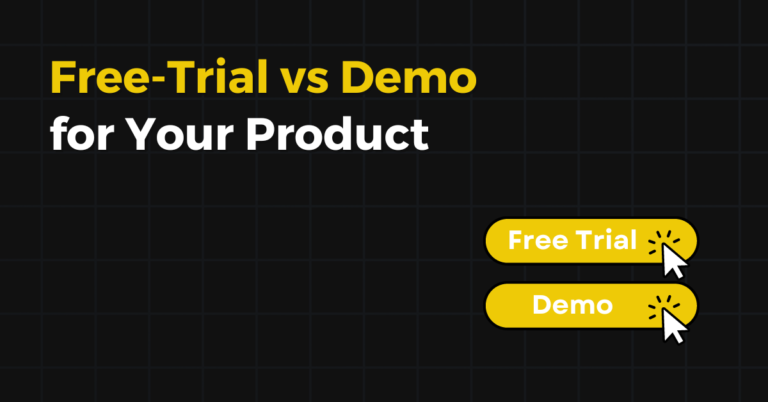A SaaS go-to-market strategy is a blueprint for how your internal teams (Content Marketing, Product, Pricing, Sales, etc.) will work together to reach your target market and demonstrate the value of your product in the shortest possible time.
Simply put, it’s how you sell your product.
If you’re a B2B SaaS company, choosing the right go-to-market (GTM) strategy is one of the most consequential choices you’ll make. There are two main types of GTM strategies: product-led and sales-led.
Many software companies default to choosing a sales-led GTM strategy because it’s what they’re familiar with (or it’s what their advisors recommend) without fully evaluating whether it’s best for them. On the opposite end of the spectrum, some founders of startups opt for a product-led GTM strategy because it’s all the rage (or they think it means they won’t ever have to talk to their customers).
Instead of basing the decision on personal preference, it’s important to work through a decision-framework that takes into account four factors:
- How complex, dynamic or new the problem and/or solution are.
- How easy it is for your customers to set up the product and start seeing results.
- How you connect with the buyer and user — top-down or bottom-up.
- How you win in your market.
In this guide, we’ll break down the differences between the two main GTM strategies and provide examples of companies that use each one. Then, we’ll walk you through a decision framework to help you decide which one is right for you.
It can be difficult to build the right GTM strategy from the ground up or switch your existing GTM strategy. That’s why we created the ProductLed Accelerator program to equip teams with the knowledge, resources, and skills to implement product-led growth. If you’re not sure if a product-led GTM strategy is right for your SaaS business, take our free course on the fundamentals of product-led growth.
Sales-Led Go-to-Market Strategy
In a sales-led GTM strategy, the entire buying process is supported by a sales rep. The potential customer learns about the product through live demos and settles on a price by negotiating with a salesperson. Then, the sales rep hands the customer to the Customer Success team, who leads the onboarding process.
One of the main benefits of a sales-led GTM strategy is the ability to win customers with high lifetime value (LTV). The other main benefit is that you can build personalized relationships with your customers, which can give you an edge in competitive environments. These two reasons are part of why a sales-led GTM strategy has historically been the default strategy for most businesses. However, sales-led growth has some major downsides.
Firstly, sales-led growth has a high customer acquisition cost (CAC) when compared to product-led growth. There are three reasons for this:
- Training a salesforce and paying their salaries is expensive.
- The sales cycle is long because it requires back-and-forth communication between the salesperson and the prospect.
- Sales teams need inbound leads (which are more effective than cold-calling), so they rely on paid marketing campaigns with built-in costs for every lead (regardless of the customer lifetime value).
Secondly, most modern users want to test a product before they buy. If a product is simple and easy to use, talking to a salesperson adds unnecessary friction, which means you’ll close fewer deals.
Product-Led Go-to-Market Strategy
Product-led growth is a go-to-market strategy where you provide a self-serve buying process. The product engages, educates, and onboards the customer. This is typically done by providing a free trial or freemium version of the product where the customer has the opportunity to experience the value of the product on their own. When they experience the product solving their pain points, it becomes an easy decision to sign up for the paid product.
Related: 5 Steps to Improve Your Free Trial Conversion Rate
This product-driven customer experience also creates the opportunity to turn the traditional sales funnel into a flywheel. The flywheel model uses positive experiences inside the product to propel customers onto the next level of engagement — from beginners to loyal customers. Plus, using the flywheel model helps increase customer referrals and reduce churn.
A product-led GTM strategy typically has a much lower CAC than sales-led growth because the sales cycle is shorter and you can convert prospects into paid customers with fewer touchpoints (and without a Sales team). Additionally, you can use B2B marketing strategies like SEO to draw in customers organically.
While this may sound like there’s no room for a Sales team when using a product-led strategy, the opposite is true. Sales-led growth and product-led growth are two ends of a spectrum with many combinations in between.
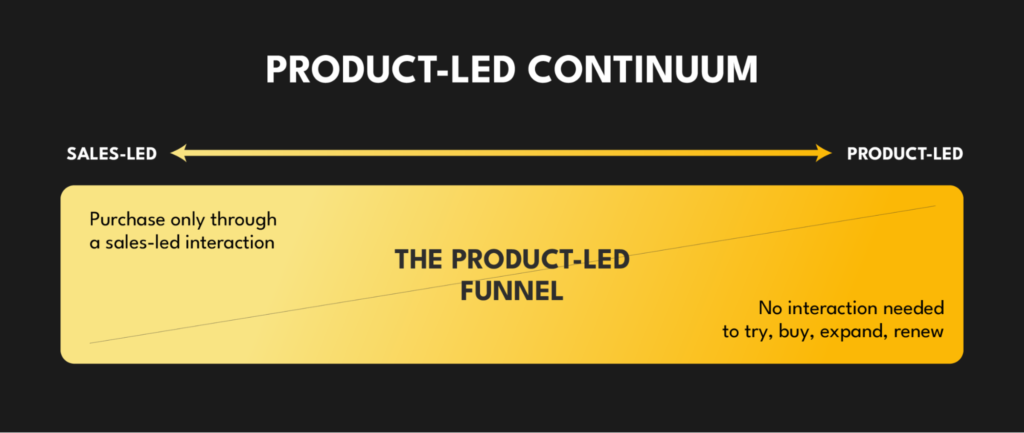
For example, many companies provide a self-serve version of their software that anyone can use but also have a Sales team reach out to their biggest prospects. In this scenario, the product is the main source of lead generation for the Sales team, but the Sales team doesn’t stand in the way of smaller users who want to experience the product on their own.
Related: Product-Led Growth: Why It’s the Future of SaaS
If you’d like to get started with a product-led GTM strategy, we can help. Sign up for our four-week program to align your team, choose the right free model, and ultimately gain more customers.
How to Choose Between a Product-led and Sales-led Go-to-Market Strategy
The right GTM strategy for your business is the one that lets your customers experience the value of your product in the shortest amount of time possible so that they become paying customers for a long time.
Choosing your GTM strategy needs to be a conscious decision. Otherwise, you will likely end up wasting time and resources implementing the wrong strategy. Additionally, you’ll need a detailed plan for how to implement your GTM strategy (that includes everyone from the Marketing team to Product Development) if you want it to be successful.
For example, many established companies that attempt to switch to a product-led GTM strategy typically start by offering a free trial or freemium service. However, if this is the only part of the sales process that changes, the GTM strategy will likely fail. Many companies see this failure as a sign that product-led growth is wrong for their business. However, a product-led GTM strategy is more than just offering a free trial — it’s a new way of selling that impacts every part of the company.
The following questions will help you decide if a product-led GTM strategy is right for you.
Note: The strategy that’s right for your business can change over time, so it’s important to revisit these questions on a regular basis.
1. Is the problem and/or solution difficult to convey or different for each customer?
The first consideration when deciding to use a product-led or sales-led strategy is the complexity of the problem you solve and the solution you’re providing. If the problem or solution is highly technical or if it changes with every customer, it will be difficult to communicate the value of your product without an in-person conversation.
For example, SAP is a multinational software company that provides accounting, enterprise resource planning, human resources, and supply chain management solutions for enterprises. Each customer they work with has highly intricate, complex use cases, and the solutions SAP provides are customized to each customer. SAP can only share the value of their service by having a sales person learn about the prospect’s needs and then create a custom proposal.
On the other hand, a business like Slack provides the same product for all users and solves a simple problem. Slack has seen great success with a product-led GTM strategy because their customers are able to understand how the product solves their problems simply by using it.
Another point to consider is that a solution may be difficult to convey simply because it's new. If no one has ever heard of or experienced the solution you’re offering, they may need someone to walk them through the value proposition of the solution before they’re bought in. In that case, you may need to start with a sales-led strategy until the solution becomes more commonly known.
However, if no one’s heard of products like yours but it’s a simple concept, you may be able to use a product-led strategy from the start.

2. How easy is it for your customers to set up the product and start seeing results on their own?
The next question to consider is whether or not your prospective customers have the expertise and bandwidth to set up and begin using your product. Returning to the Slack example, any professional can easily set up a Slack account, add coworkers, and start sending messages, so a product-led approach is likely the best choice.
On the other hand, migrating to a new payroll and HR system typically requires a lot of configuring on the back-end before it’s operational. It would be difficult for a company to set up a new payroll software and see the value of it during a free trial, which is why you would need a sales rep to demonstrate its value.
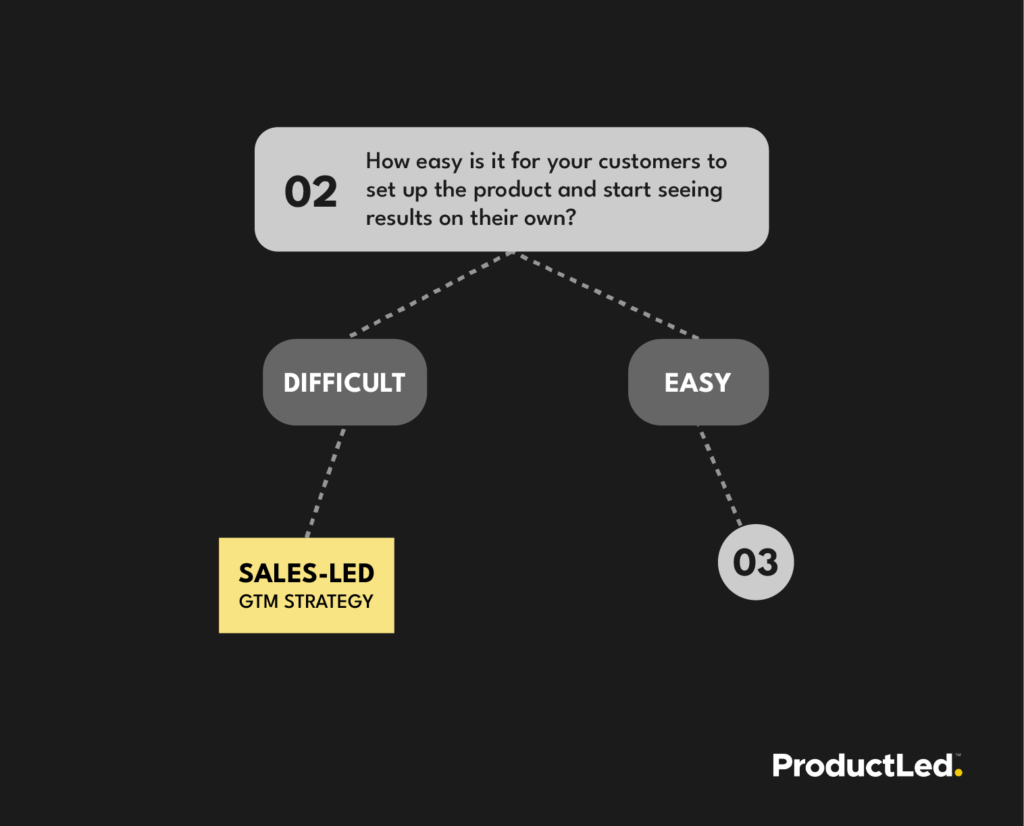
3. Are you going to take a top-down or bottom-up selling approach?
In B2B sales, where you often have managers making decisions for an entire team about what SaaS products to purchase and adopt, there are generally two selling approaches: top-down or bottom-up.
A top-down selling approach is when you start by attracting the buyer, who then passes the product down to the users. This sales strategy is most effective in situations where it’s important for everyone on the team to use the same product, as with CRMs and task management tools.
A top-down selling approach often lends itself to a sales-led GTM strategy because CEOs and other key decision-makers typically don’t want to take the time to learn about the product on their own. They’d rather have someone present the solution to them and get the opportunity to ask detailed questions right away.
A bottom-up selling approach starts with attracting the user, who then convinces the higher-ups to invest in the product for the entire team. This approach is most effective when it’s possible for different people to use different solutions within the same company.
For example, one employee may start using Loom to record quick explainer videos for their coworkers instead of explaining things via email or in-person. Then, their coworkers might start recording Loom videos, too. Eventually, if enough people are regularly using Loom and exceeding the limits of its free plan, they may ask managers to provide access to the premium version.
A bottom-up selling approach is usually paired with a product-led GTM strategy because most individual users prefer to self-educate rather than meet with a salesperson.
Note: When you’re targeting a single stakeholder who’s both the user and the buyer, a product-led GTM strategy is usually the most effective. Again, this is because most individual users prefer to self-educate.
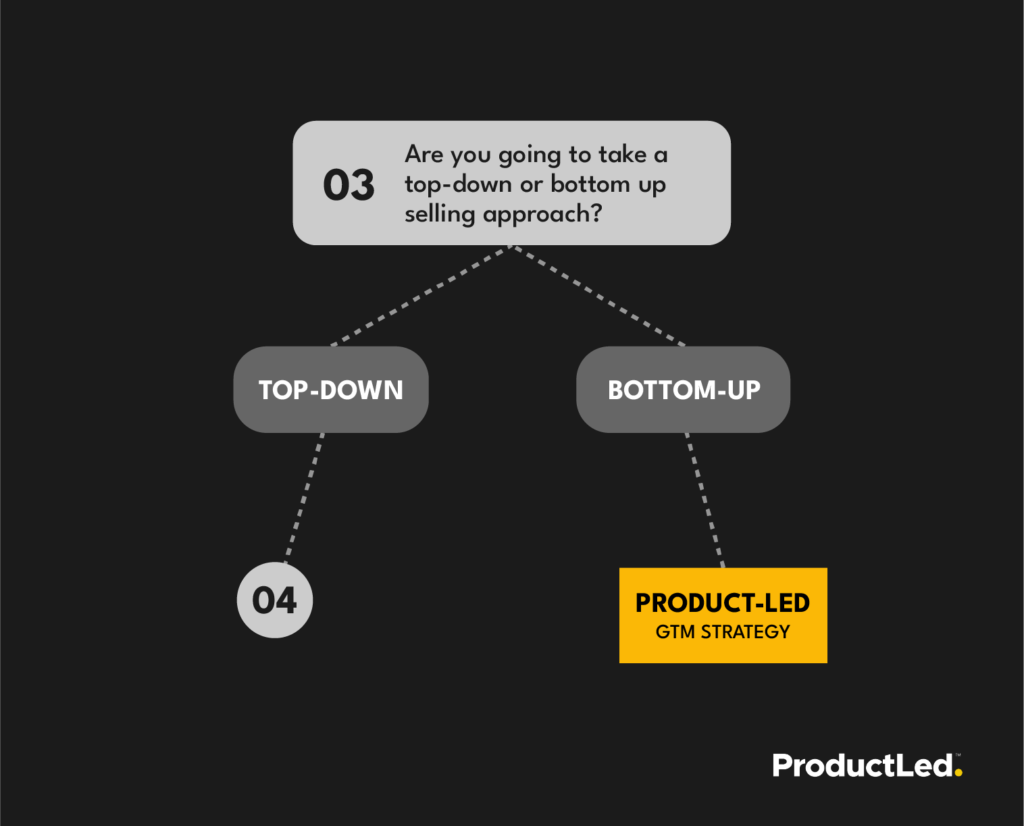
4. How do you win in your market?
The final factor in determining if a sales-led GTM strategy is right for you is your business strategy for beating the competition and growing your customer base. In competitive markets, there are three main categories:
- Differentiated: A differentiated business strategy is when many other businesses offer the same product or service that you do but your offering is better in some way (e.g., faster, better quality, or customized to serve the needs of a niche group, such as time clock software for construction workers).
- Disruptive: A disruptive business strategy is when many other businesses have the same offerings as you but you charge less for the same product or service.
- Dominant: A dominant strategy is when you combine the other two strategies: you charge less and provide a better product/service.
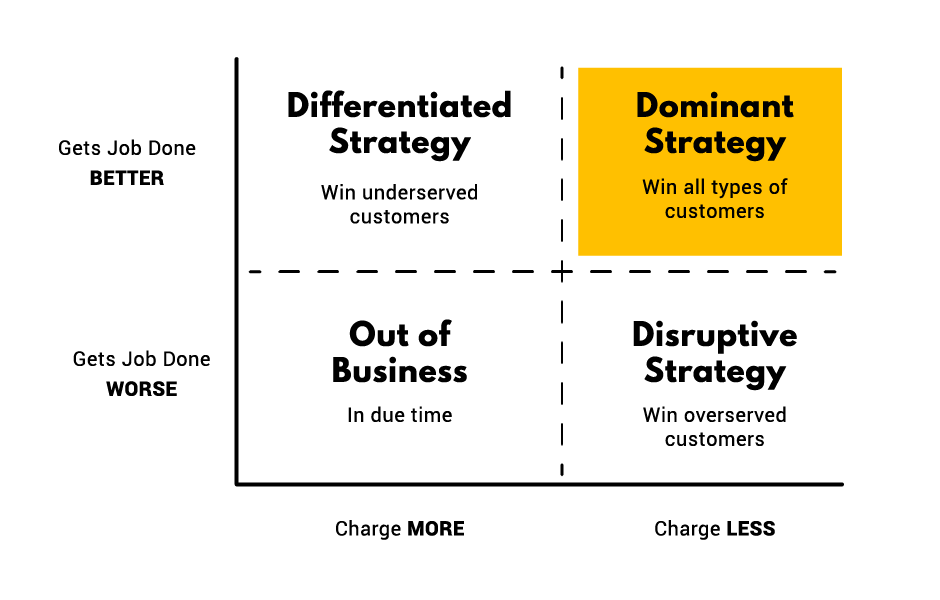
If charging less than your competition is a key part of how you win, as in the disruptive or dominant business strategies, a product-led GTM strategy will help you keep costs down.
If you’re using a differentiated business strategy and cost is less of a factor, you could choose a sales-led GTM strategy. However, a sales-led model would leave you vulnerable to new competitors who attempt a dominant strategy in your market. We recommend you implement a product-led strategy to help ensure longevity of your business.
Related: How to Choose the Right SaaS Pricing Model
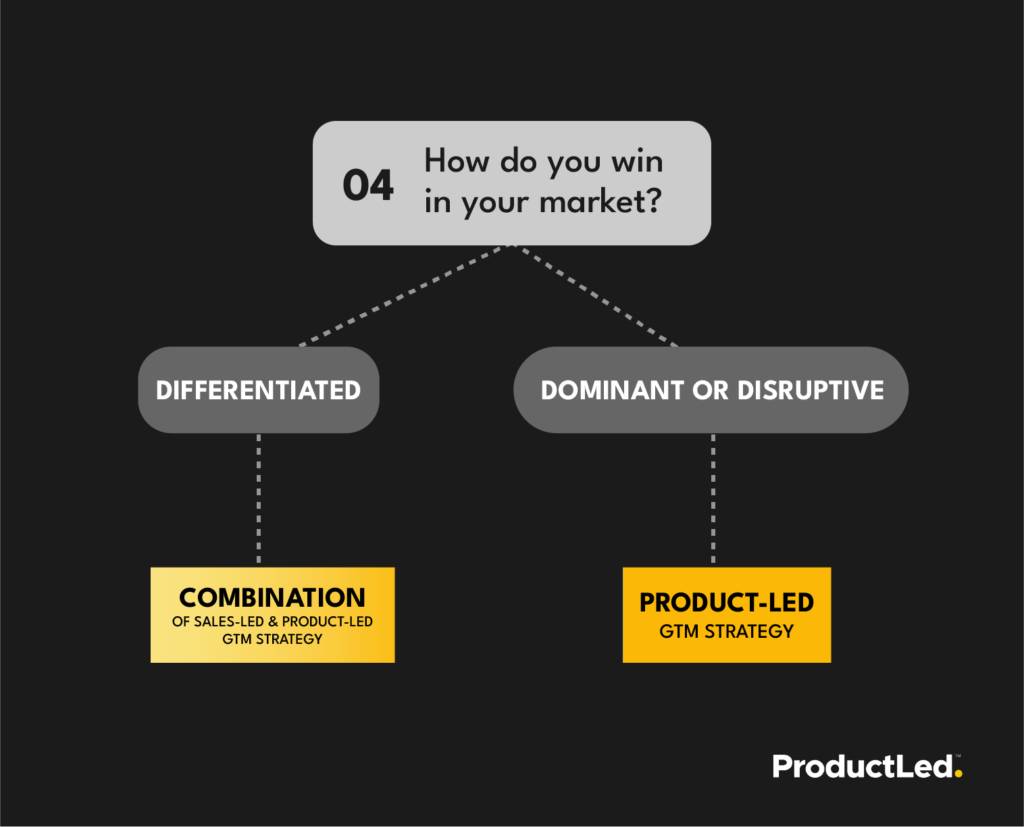
Flowchart for Determining if Product-led Growth Is Right for You
This flowchart is meant as a general guide. What works for one company may not work for another. If you’d like guidance on choosing the right GTM roadmap for your business, reach out to our team.
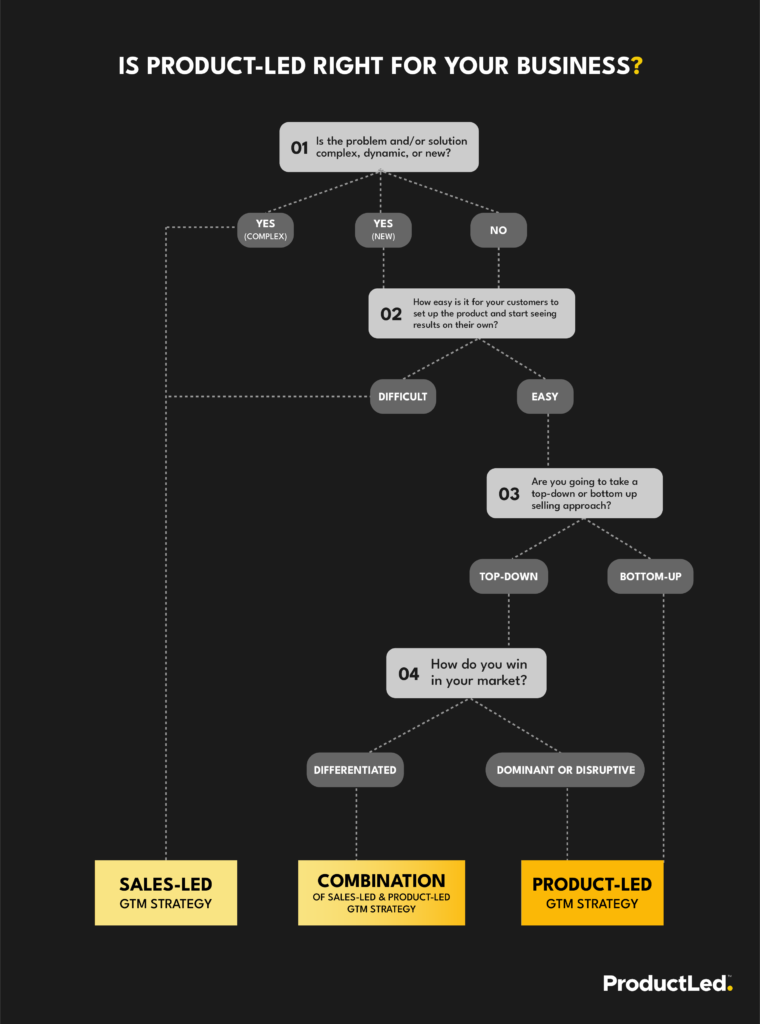
Build Your Product-Led Go-to-market Strategy in Our Four Week Program
If you think a product-led GTM strategy could be right for your business but don’t know where to start, we can help. Many transitions to product-led growth fail, but our four week ProductLed Accelerator program was designed to fix that. Having helped 600+ students and 300+ companies smoothly transition to a product-led growth strategy, we understand the common pitfalls companies fall into and how to solve them.
Our online program helps you:
- Choose a free model that will attract your target audience (freemium, free trial, or one of three hybrid models)
- Align your team on product-led growth
- Know how to execute your new go-to-market plan (and track the right key performance indicators)
You’ll have access to:
- Strategy examples, decision frameworks, templates, and worksheets so you can learn how to put the strategies to work for your company
- Webinar workshops every Tuesday during the four weeks to answer questions and offer feedback
- A private Slack group to connect with your cohort and get help from leading industry experts
Plus, you have access to all course materials for a year.
Whether you have an upcoming new product launch, are entering a new market, or want to update your existing strategy, we give you the tools you need to launch a product-led GTM strategy that’s customized to fit your product.
You can learn more about the impact of the program by reading these case studies:
- How a $4B Dollar Business Smoothly Transitioned to Being Product-led
- How Jebbit Made the Transition From Sales-Led to Product-Led
- How Enzuzo launched a profitable freemium model and how you can too
Enroll in our next cohort to start your transition to product-led growth.




